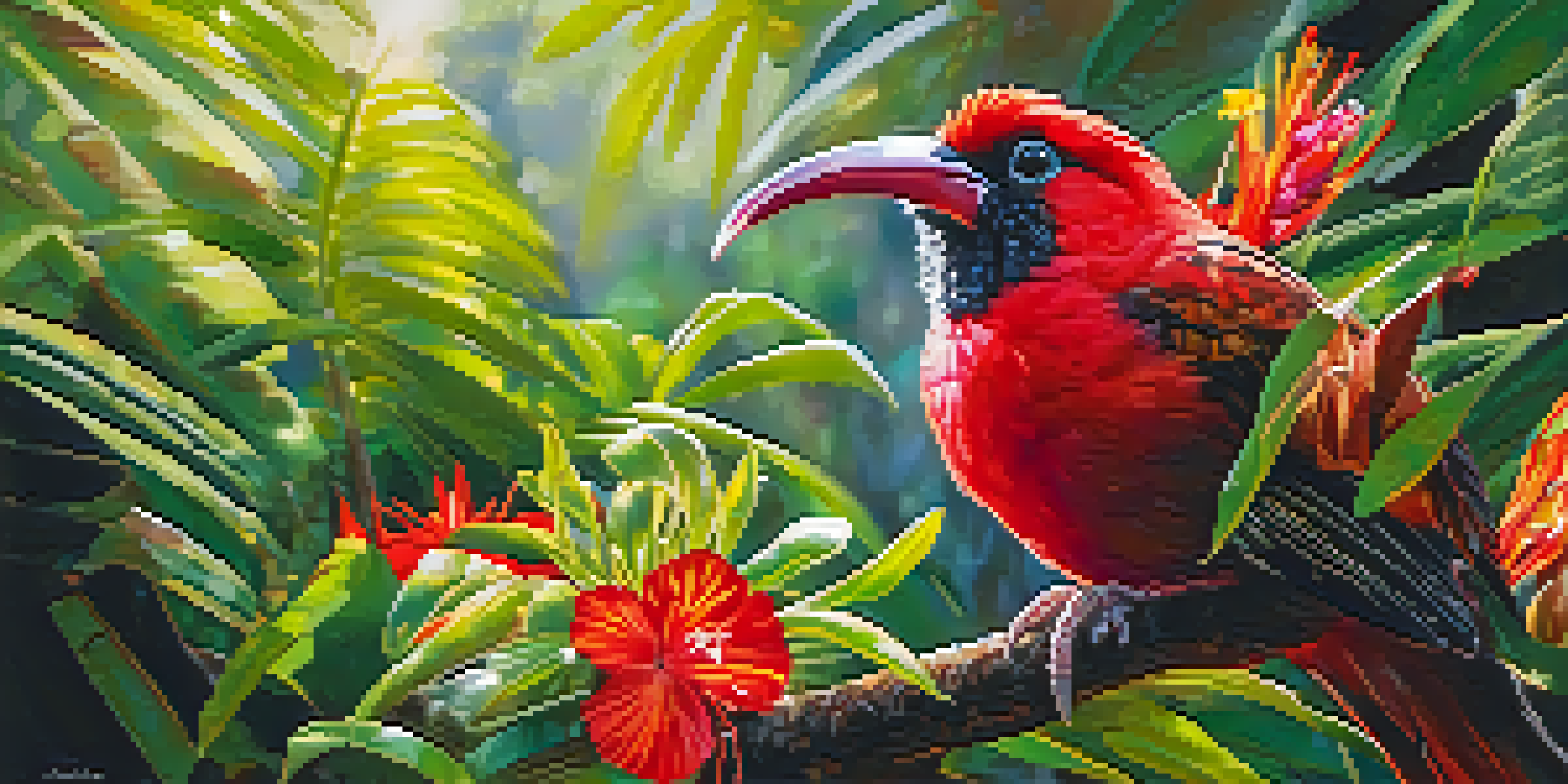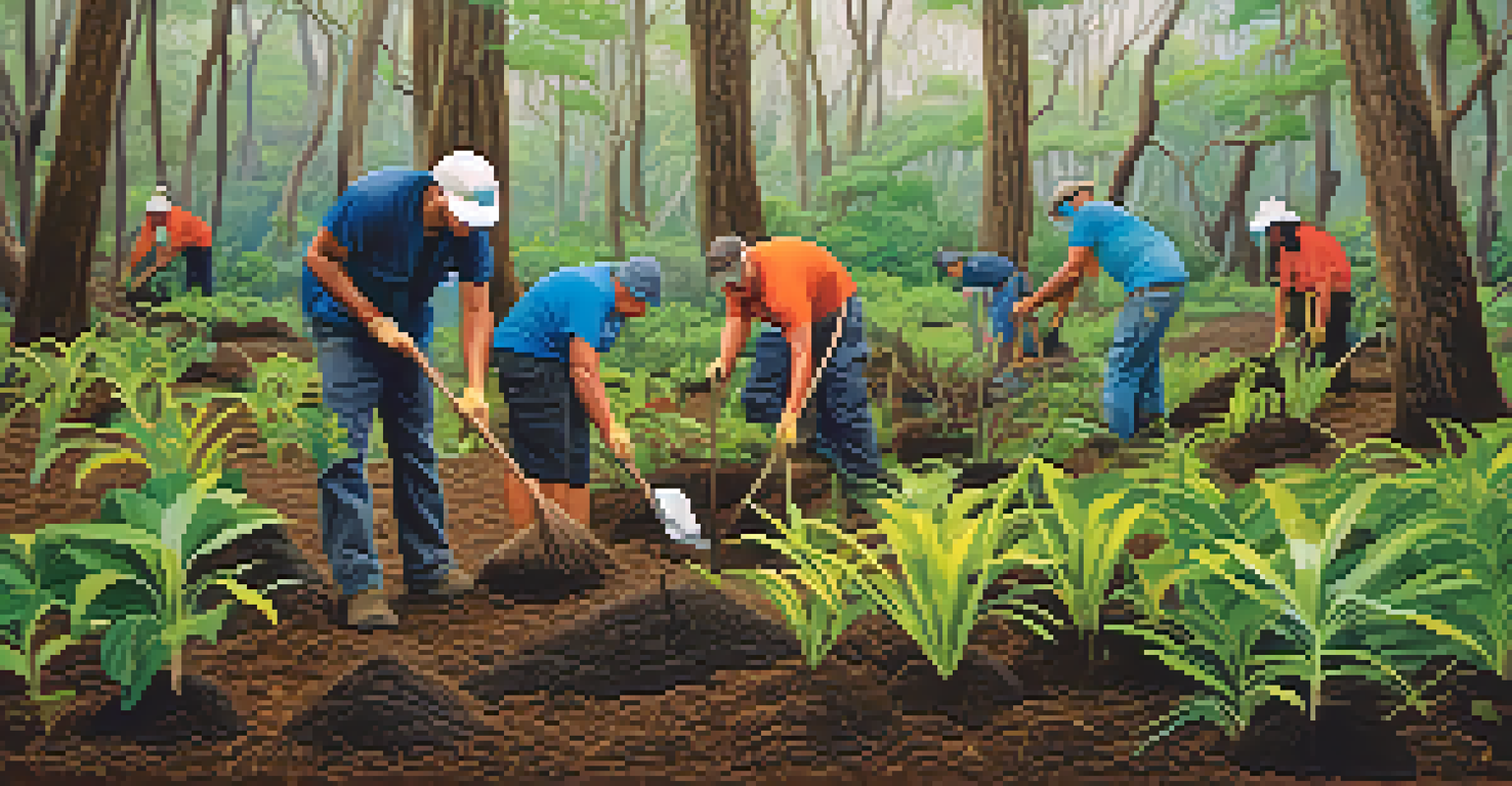Restoration Efforts for Hawaii's Endangered Bird Populations

Understanding Hawaii's Unique Bird Populations
Hawaii is home to a remarkable array of bird species, many of which are found nowhere else on Earth. The isolation of the islands has led to the evolution of unique birds, like the 'I'iwi and the Hawaiian Goose, or Nene. However, this uniqueness comes with vulnerability, as habitat loss and introduced predators threaten their survival. Understanding these birds is crucial for prioritizing effective conservation efforts.
In every walk with nature one receives far more than he seeks.
The biodiversity in Hawaii reflects not just the beauty of nature, but also its fragility. Many species have already become extinct due to human activity and environmental changes. This situation underscores the urgency of restoration efforts aimed at protecting the remaining populations. By learning about these birds, we can better appreciate the importance of preserving their habitats.
Additionally, some birds play critical roles in their ecosystems, such as pollination and seed dispersal. Their decline doesn't just affect their populations but also the overall health of the environment. Thus, every effort to understand and protect these birds ties back to the well-being of the entire ecosystem in Hawaii.
The Impact of Habitat Loss on Bird Populations
Habitat loss is one of the most significant threats to Hawaii's bird populations. Urban development, agriculture, and invasive species have drastically altered the natural landscapes where these birds thrive. As their habitats shrink, many species struggle to find food and nesting sites, leading to a decline in their numbers. This loss of habitat is not just a local issue; it has global implications for biodiversity.

Invasive species, such as rats and mongooses, further exacerbate the situation by preying on native birds and their eggs. For instance, the ground-nesting birds are particularly vulnerable to these predators. Conservationists are working tirelessly to control these invasive populations and restore the balance within the ecosystem. Their efforts are crucial in creating a safer environment for Hawaii's unique birds.
Hawaii's Birds Face Habitat Loss
The unique bird populations in Hawaii are severely threatened by habitat loss due to urban development and invasive species.
Moreover, climate change poses an additional challenge, altering weather patterns and impacting food sources for these birds. Rising sea levels threaten coastal habitats, while changes in vegetation affect the availability of essential resources. Addressing habitat loss requires a multifaceted approach, combining habitat restoration with climate resilience strategies.
Conservation Programs in Action
Numerous conservation programs are actively working to protect Hawaii's endangered bird species. Organizations like the Pacific Bird Conservation and the Hawaiian Wildlife Fund are at the forefront of these efforts. They implement strategies such as habitat restoration, predator control, and public education to foster a better understanding of these issues. Engaging the community is key to the success of these programs.
What we are doing to the forests of the world is but a mirror reflection of what we are doing to ourselves and to one another.
One notable initiative is the 'Save Our Species' campaign, which focuses on restoring native forests critical for birds like the Hawaiian Honeycreeper. By planting native trees and removing invasive plants, these programs aim to create a more suitable habitat for the birds. Volunteers from local communities often participate in these restoration projects, fostering a sense of connection and stewardship for the land.
Additionally, breeding programs for endangered species, such as the Hawaiian Goose, have been successful in increasing population numbers. By raising birds in controlled environments and later releasing them into the wild, conservationists are helping to boost dwindling populations. These hands-on efforts illustrate the dedication and innovation required to save Hawaii's birds from extinction.
The Role of Community in Bird Conservation
Community involvement is vital in the fight to save Hawaii's endangered birds. Local residents can participate in monitoring bird populations and reporting sightings, which provides valuable data for conservation efforts. Additionally, educational programs in schools and community centers help raise awareness about the importance of protecting these unique species. When communities are engaged, conservation efforts are more likely to succeed.
Grassroots initiatives often lead to innovative solutions tailored to local challenges. For instance, local volunteers might organize clean-up events to remove trash from critical habitats or host workshops to educate others about the threats facing native birds. These actions not only support bird conservation but also foster a sense of pride and responsibility among community members.
Community Engagement is Crucial
Local involvement in monitoring and conservation efforts significantly enhances the effectiveness of programs aimed at protecting endangered birds.
Moreover, tourism can play a significant role in supporting conservation efforts. Eco-tourism initiatives that focus on bird watching can generate funding for local conservation projects. Encouraging responsible tourism practices helps ensure that visitors appreciate Hawaii's natural beauty while contributing to the ongoing protection of its endangered bird populations.
Innovative Technology in Bird Conservation
The use of technology in conservation efforts is transforming how we protect Hawaii's endangered birds. Tools like remote cameras and GPS tracking provide researchers with critical data on bird behavior, migration patterns, and habitat use. This information is essential for developing targeted conservation strategies and monitoring the success of restoration efforts. Technology not only enhances our understanding but also allows us to respond more effectively to emerging threats.
Drones are another exciting innovation aiding conservationists in monitoring remote habitats. They can cover large areas quickly, helping to identify invasive species or assess habitat conditions without disturbing wildlife. This capability ensures that conservationists can focus their efforts where they are most needed, optimizing resources for maximum impact.
Furthermore, citizen science initiatives leverage smartphone apps to engage the public in bird monitoring efforts. These platforms allow everyday people to report sightings and contribute to important databases that inform conservation strategies. By harnessing technology and community involvement, we can create a more comprehensive approach to preserving Hawaii's endangered bird populations.
Success Stories in Bird Restoration
While the challenges are significant, there are numerous success stories in Hawaii's bird restoration efforts. The recovery of the Nene, or Hawaiian Goose, is a shining example. Once on the brink of extinction, intensive conservation measures, including captive breeding and habitat restoration, have led to a resurgence in their population. This success demonstrates that with the right strategies, it is possible to reverse the tide for endangered species.
Another inspiring story is that of the 'I'iwi, a bird celebrated for its striking red feathers. Conservationists have worked diligently to protect its habitat and manage invasive species. Their efforts have led to population stabilization in some areas, showcasing the positive impact of focused conservation work. These stories serve as a beacon of hope for other endangered bird species in Hawaii.
Technology Aids Conservation Efforts
Innovative tools like drones and citizen science apps are transforming how conservationists monitor and protect Hawaii's endangered bird species.
These success stories highlight the importance of continued investment in conservation efforts. Each victory not only boosts the morale of conservationists but also encourages community involvement and support. By sharing these successes, we can inspire others to take action and contribute to the ongoing fight for Hawaii's birds.
Looking Ahead: The Future of Hawaii's Birds
The future of Hawaii's endangered bird populations hinges on sustained conservation efforts and community engagement. As challenges like climate change and habitat loss continue to evolve, adaptive management strategies will be essential. This means being flexible and responsive to new information and changing circumstances, ensuring that conservation measures remain effective.
Collaboration among various stakeholders, including government agencies, non-profits, and local communities, will be crucial in shaping the future of bird conservation. By pooling resources and expertise, these groups can implement comprehensive strategies that address the multifaceted challenges facing Hawaii's birds. Together, they can create a robust framework for preserving the islands' unique avian diversity.

Ultimately, the success of these efforts will depend on the collective commitment to safeguarding Hawaii's natural heritage. By fostering a culture of conservation and valuing the unique role that birds play in the ecosystem, we can ensure that future generations inherit a vibrant and thriving natural environment. The journey to protect Hawaii's endangered birds continues, and every action counts.